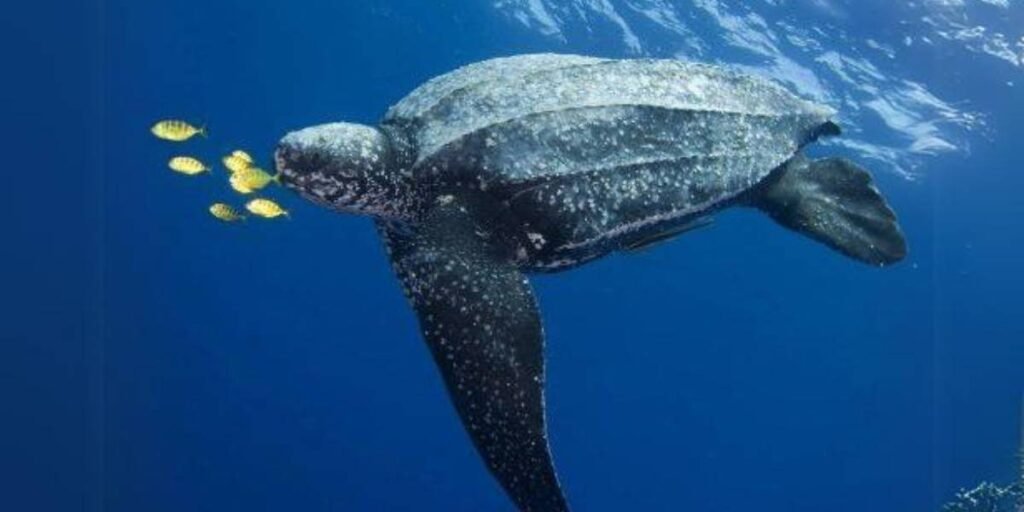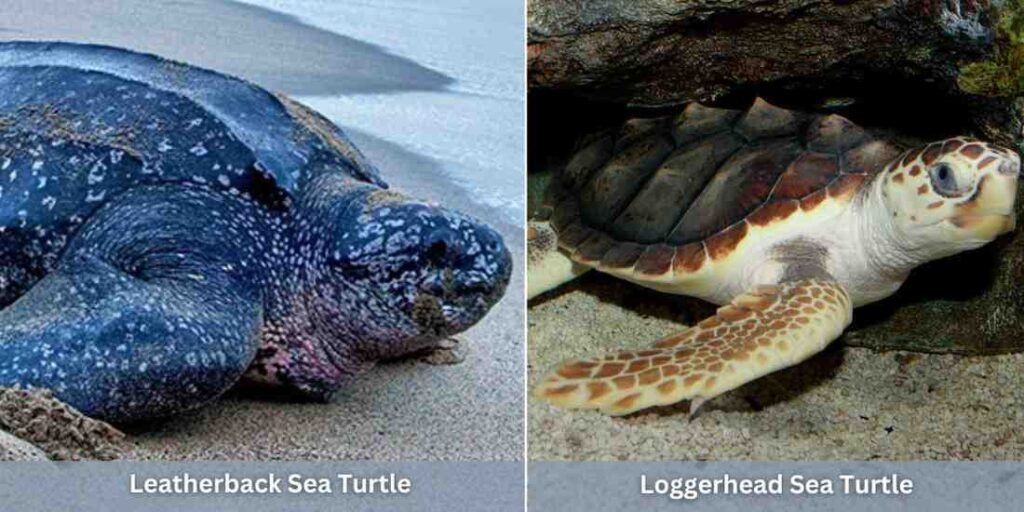The leatherback sea turtle is the largest and most migration-driven of all sea turtles. There are many inspiring wonders and innumerable questions regarding this majestic sea turtle’s physiology. Leatherback sea turtles are known for their distinct leathery shell. One of the most curious aspects is the leatherback sea turtle bite. Many people wonder if this is because of their size; when their size is so large, how will be – leatherback sea turtle bite?
Even though all other qualifications make the creature a gentle giant, this attribute varies depending on the part of the body since the jaws tend to bite. It is evident that with time, all creatures evolve towards becoming lean and proficient at using what they have for maximum benefit. So, today we will be diving into leatherback sea turtle bite, according to our research.
Do Leatherback Sea Turtles Bite?
Leatherback sea turtles can bite, but they are typically not very aggressive. Being the largest species of sea turtle, this type of turtle is usually very warm. Their main food is jellyfish, and their mouths are equipped to facilitate this process. Their jaws feature sharp scissor-shaped cutting edges, and the back of their throats is armed with spines pointing backward.
Behavior-wise, leatherbacks aren’t considered much of a threat to people. Unlike most marine turtle species, they spend the vast majority of their lives in the open ocean and are rather elusive. Leatherbacks are typically quite passive and will attempt to stay away from people as long as the latter don’t go near them. Nonetheless, even the most passive of animals will defend themselves if they feel cornered. As such, if a turtle is inadvertently caught in the fishing nets or someone tries to handle them incorrectly, they may bite.
Although their jaws are made to bite soft-bodied prey like jellyfish, they can deliver a forceful bite as well. Generally, they don’t bite, and it’s more of a defensive measure than anything aggressive. In their natural habitat, these turtles play a vital role in maintaining marine ecosystem balance by controlling jellyfish populations.
What is The Bite Force of a Leatherback Sea Turtle?

Leatherback sea turtles are the largest of all turtle species, with their size ranging from 4 to 6 feet in length. They weigh between 500 to 1,500 pounds. Given the sheer size and weight of these magnificent creatures, it is safe to assume that their bite force exceeds that of the loggerhead sea turtles. Considering the size of loggerhead —in general, they measure 2.5 to 3.5 feet in carapace length and weigh from 155 to 375 pounds.
Now, why we are talking about loggerhead sea turtle size? We looked in-depth but didn’t find any specific bite force data on leatherback sea turtles. But, we found loggerhead sea turtle bite force info, so decided to do a comparative analysis to understand leatherback sea turtle bite force.
According to the Journal of Experimental Biology, research, juvenile loggerhead turtles have a bite force that can range from approximately 330 to 575 N. Adult loggerhead sea turtles’ bite force can reach up to 1766N.
So, it is quite logical to assume that leatherbacks have a bigger bite force than loggerheads since leatherback sea turtles are considerably larger. Accordingly, if loggerheads have a bite force difference of 1766 N, leatherbacks might have a bite force of 2000 N or maybe more. However, there are no accurate data or calculations, but this would be logical assuming their size. There can be another assumption that, leatherback sea turtles’ bite force may not be so much higher as their food habit is consuming jellyfish. For eating soft fish they might not need too much bite force.
Leatherback Sea Turtle Bite Vs. Loggerhead Sea Turtle Bite Force Comparison

Loggerhead sea turtles are known for their strong jaws and high bite force because they eat hard-shelled prey such as crabs and mollusks. Leatherback sea turtles, on the other hand, are even larger and possess even more robust physical attributes. So it is possible to speculate that their bite force is at least as high as loggerhead but not less. This is supported by their ecological roles and dietary needs.
Leatherback sea turtles mainly eat jellyfish. While jellyfish may not require the biting force necessary for prey with hard shells, their strong jaws allow them to grasp and control slippery, gelatinous items while floating in the ocean currents. This act plays a vital part in preserving aquatic life by regulating jellyfish populations.
| Feature | Loggerhead Sea Turtles | Leatherback Sea Turtles |
| Bite Force | Juveniles: 330 to 575 N; Adults: up to 1766 N | Potentially 2000 N or more due to larger size |
| Dietary Needs | Hard-shelled prey, including crabs and mollusks | Primarily jellyfish, adapted for grasping and managing slippery foods |
| Ecological Role | Helps control populations of hard-shelled marine organisms | Contributes to regulating jellyfish populations, maintaining balance in marine ecosystems |
| Adaptations | Strong jaws for crushing hard prey | Powerful bite to manage gelatinous diet in ocean currents |
| Size and Physical Attributes | Smaller than leatherbacks, strong jaws | Largest of all sea turtles, robust physical attributes, potential for greater bite force |
However, even though we do not have much data on Leatherback sea turtles’ specific numerical bite force, a comparison with loggerheads and their size and diet makes an important point. The leatherbacks are often bigger and heavier, hence their bite force may be well-suited to their environmental adaptation. This helps them survive and feed in the ocean more effectively.
How Leatherback Sea Turtle Bite & Eat Their Food?
Leatherback sea turtles have powerful jaws, which is a critical adaptation for their survival. Despite the absence of the teeth, their jaw is modified and has sharp, cum-like points, which helps them to grab their main prey – jellyfish. This feature is highly important since leatherback’s diet is mostly based on jellyfish.
However, even without teeth, their jaws are strong enough to grasp such a soft-bodied animal in the water. When caught, the jellyfish is pierced by pointed cusps and held until the turtle swallows it whole. This simple and pretty efficient way of eating comes from the leatherback’s jaw structure in feeding on soft-bodied marine creatures.
How Leatherback Turtles Biting Behavior Helps Their Defense?
Leatherbacks are known as the gentle giants of the turtle world, but their biting behavior demonstrates an important aspect of their defenses. When they feel threatened, these turtles can snap at anything that comes near their mouths with blinding speed. The bite force of a leatherback sea turtle can leave small creatures or unwary human beings with painful bruises, broken bones, or severed limbs.
Combined with their great size and speed, the leathery giants’ biting capability helps to keep them secure against dangers in the ocean. In that sense, the leatherback’s bite, while potentially lethal, is a reminder of its prowess and resourcefulness.
There is another giant and robust structured freshwater alligator snapping turtle. If you want to know more about alligator snapping turtle bite force, you can check here.
Takeaway
Overall, direct measurements of leatherback sea turtle bite force are needed to achieve precise data. However, there is a substantial amount of information regarding their anatomy and diet. This information helps us get a vivid picture of these sea turtles ‘ biting capabilities. Additionally, it helps demonstrate the significance of this species for the marine environment. It is particularly valuable considering the current challenges to this ecosystem.
